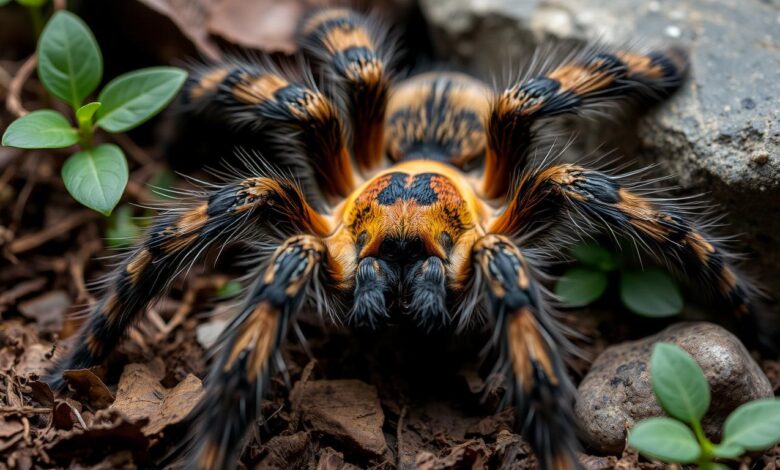How likely is it that a tarantula will bite you?

Tarantulas are often feared because of myths about their biting habits. But, the truth is, tarantulas rarely bite humans. They usually try to stay away from people. It’s good to know how to handle them and what to do if they do bite.
Tarantulas are big and look scary, but they are mostly calm. They don’t like to fight with humans. They only bite when they’re really scared or upset. In fact, getting bitten by a tarantula is less likely than by some snakes or scorpions.
Still, it’s important to be careful around tarantulas. They can defend themselves if they feel threatened. Knowing how to handle them safely lets you enjoy their beauty without worry.
Understanding Tarantula Behavior
Tarantulas are usually calm and try to stay away from trouble. But, they might bite if they feel scared or threatened. It’s important to know how they act to safely keep them as pets.
The way a tarantula behaves can change based on its species, size, age, and personality. Even though tarantulas are not naturally aggressive, some things can make them more likely to bite. Things like their environment, how they’re handled, and what they see as threats can affect their behavior.
Tarantula Defense Mechanisms
When tarantulas feel scared, they might bite or use other defense mechanisms. They could stand up on their hind legs, kick hairs, or pretend to be dead. Knowing these arachnid defense mechanisms helps pet owners know when a tarantula is upset and how to avoid getting bitten.
Being a responsible exotic pet owner means doing lots of research and handling them right. By learning about tarantula behavior and how they act, fans can enjoy these amazing creatures safely. This way, they can make sure both the tarantula and they stay safe.
Factors Influencing Bite Likelihood
Several factors can affect whether a tarantula bites. The tarantula’s species, size, age, and temperament play a big role. Larger and more aggressive tarantulas, especially younger ones, are more likely to bite.
How the tarantula behaves and what it sees as threats can also lead to biting. Tarantulas usually avoid fights but might bite if they feel threatened. Keeping a safe distance and handling them carefully can lower the risk of a bite.
- Tarantula species and size: Larger, more aggressive species are more likely to bite.
- Tarantula age: Younger, less experienced tarantulas may be more prone to biting.
- Tarantula temperament: Calm, docile individuals are less likely to bite than aggressive ones.
- Perceived threats: Tarantulas may bite if they feel threatened or provoked.
- Handling techniques: Proper handling can help reduce the risk of a tarantula bite.
Knowing these factors helps tarantula lovers and owners keep safe. It ensures a fun and safe time with these amazing creatures.
How likely is it that a tarantula will bite you?
The risk of a tarantula biting you is low. These arachnids usually avoid fights and bite only when they must. The risk depends on the tarantula’s species, size, age, and temperament.
Bigger, more aggressive tarantulas might bite more than smaller ones. Young tarantulas, especially, may bite when they’re scared or unsure. Knowing about tarantula behavior and temperament can help avoid bites.
Handling tarantulas right and respecting their space lowers the tarantula bite risk. Don’t make sudden moves or loud noises. Move slowly and calmly, and let the tarantula retreat if it wants to.
Even though the spider bite risk might seem high, tarantula bites are rare. By understanding and respecting these creatures, you can enjoy their world safely. For more on tarantula bite first aid, see our detailed guide.
 Can tarantulas kill you?
Can tarantulas kill you?
Tarantula Venom: Myths and Facts
Many people think tarantula venom is very dangerous. But, it’s mostly just mild to moderate reactions in humans. These can include pain, swelling, and redness. Serious problems are very rare, especially with quick medical help.
The venom of most tarantulas isn’t a big deal for humans. The chance of a bad reaction is much lower than with other spiders. In fact, tarantula venom is generally less potent than that of a honeybee.
Tarantula Venom Myths Debunked
One myth is that tarantula venom can kill a human. This is not true. While it can be uncomfortable, it’s very unlikely to be deadly, as long as it’s treated right. Another myth is that tarantula bites are extremely painful. But, the pain can vary and is often like a bee sting.
It’s key to remember that tarantulas are generally not aggressive. They only bite if they feel threatened or provoked. With the right care and respect, the chance of a bite is much lower.
In summary, tarantula venom can cause some reactions, but serious problems are very unlikely. Knowing the truth helps exotic pet lovers enjoy these amazing creatures without worry.
Signs of an Agitated Tarantula
Keeping tarantulas as pets requires knowing when they’re upset. Tarantula behavior and tarantula temperament can differ. But, spotting signs of an agitated tarantula helps lower the spider bite risk for both you and your pet.
Tarantulas are usually calm and like to stay away from trouble. But, they might get defensive if they feel scared. Look out for these behaviors:
- Rearing up on their hind legs, which can be a sign of aggression.
- Kicking urticating hairs, which can irritate you if they touch you.
- Assuming a defensive posture, with their front legs raised and fangs showing.
If you see these signs, it’s best to give the tarantula space. Avoid sudden moves or touching it. Letting it calm down helps prevent a bite.
While tarantula bites are usually not serious, they can still cause some discomfort. Being careful and watching your tarantula can make your experience safer. This way, you can enjoy their fascinating world without worrying about bites.
Exotic Pet Safety and Responsibility
Having an exotic pet, like a tarantula, means you must be very responsible. You need to give the right home, food, and care. It’s also important to know about risks and how to help if needed.
When you own a tarantula, safety is key. These amazing creatures might look scary, but they can be great pets. Knowing how to handle them, care for them, and understand their behavior is crucial for their safety and yours.
Creating a good home for your tarantula is essential. You need to think about the size of the tank, temperature, humidity, and what they live on. Regular feeding, cleaning, and watching for health issues are part of good care.
Even though tarantulas can bite, they usually don’t want to. Being gentle and respecting their space can help avoid bites.
Being ready for emergencies is part of being a responsible pet owner. Knowing first aid and having a plan can keep you and your tarantula safe.
 Arachnophobia in Australia: How to Live with Spiders
Arachnophobia in Australia: How to Live with Spiders
Owning a tarantula is a big responsibility. By focusing on their needs, understanding them, and handling them safely, you can have a great experience. This way, you and your tarantula can both be happy and safe.
| Tarantula Species | Lifespan | Adult Size | Habitat | Temperament |
|---|---|---|---|---|
| Costa Rican Zebra Tarantula | Males: Up to 5 years, Females: Up to 20 years | 3.5 to 5 inches | Central American rainforests | Generally docile, can become defensive if threatened |
| Curly Hair Tarantula | Males: 4-5 years, Females: 8-25 years | 5-6 inches | Nicaragua and Costa Rica | Typically docile, but can become aggressive if threatened |
Tarantula Bite First Aid
Keeping exotic pets, like tarantulas, safe is key. Knowing how to handle a tarantula bite is important. Even though their bites are usually not as bad as others, it’s good to know what to do.
If someone gets bitten by a tarantula, stay calm. Clean the area with soap and water to get rid of venom. Use a cold compress or ice pack to lessen swelling and pain.
Watch for signs of a bad reaction, like nausea or trouble breathing. Even if it doesn’t seem serious, get medical help right away. This helps avoid any serious problems.
Knowing how to handle a tarantula bite is vital for exotic pet safety. Being ready and knowing what to do can help a lot. It keeps both the person and the pet safe.
| Incidence Rates | Severity of Bites | Treatment Success |
|---|---|---|
| New World tarantulas: 5% to 20% Old World tarantulas: ~50% |
Mild reactions: ~90% Severe symptoms: ~10% |
Effective first aid treatment at home for majority of cases Seek medical attention if symptoms worsen or allergic reaction occurs |
Tarantula Handling Techniques
Handling a tarantula right is key for keeping both the pet and owner safe. As fans of exotic pets, we must look out for our tarantulas’ health and safety. Learning the best ways to handle them can make your bond with your tarantula very rewarding.
When you go to a tarantula’s home, move slowly and carefully. Quick actions can scare the tarantula, making it defensive. Use tools like tongs or hooks to keep a safe distance, lowering the chance of a bite.
- Always wear thick, protective gloves when handling a tarantula. This creates a barrier between your skin and the arachnid’s fangs, providing an added layer of safety.
- Gently guide the tarantula onto the tongs or hook, ensuring a secure grip without exerting too much pressure. Avoid grabbing the tarantula directly, as this can cause undue stress and lead to a defensive reaction.
- When transferring the tarantula to a new enclosure or location, move cautiously and avoid sudden movements. Tarantulas are sensitive to vibrations and can become agitated if they feel threatened.
- Maintain a calm and confident demeanor throughout the handling process. Tarantulas can sense fear or anxiety, which may provoke a defensive response.
By using these handling tips, you can enjoy a safe and rewarding time with your tarantula. Remember, taking good care of your tarantula is important for both your safety and theirs.
| Handling Technique | Description | Benefit |
|---|---|---|
| Slow, Deliberate Movements | Approach the enclosure and handle the tarantula with caution, avoiding sudden movements. | Reduces the likelihood of startling the tarantula and triggering a defensive response. |
| Protective Gloves | Wear thick, durable gloves when handling the tarantula to create a barrier between your skin and the arachnid’s fangs. | Provides an added layer of protection against potential bites, ensuring the safety of the handler. |
| Tongs or Hooks | Use tools like tongs or hooks to guide the tarantula onto and off of surfaces, maintaining a safe distance from the arachnid. | Allows the handler to interact with the tarantula without directly touching it, reducing the risk of a defensive reaction. |
| Calm Demeanor | Maintain a composed and confident attitude when handling the tarantula, avoiding the display of fear or anxiety. | Tarantulas can sense the handler’s emotional state, and a calm approach can help prevent the arachnid from becoming agitated. |
By following these best practices for tarantula handling techniques, you can safely and responsibly enjoy the company of these fascinating arachnids while prioritizing the well-being of both you and your exotic pet.
Arachnid Defense Mechanisms
Tarantulas have more than just biting to defend themselves. They use various tactics to stay safe when they feel threatened. Knowing these defense behaviors helps owners and handlers avoid upsetting them.
Rearing Up and Kicking Hairs
One impressive defense is when tarantulas stand up on their hind legs. This makes them look bigger and scarier to predators. They also kick off their urticating hairs, which can hurt the skin and eyes of anyone nearby.
Playing Dead
Some tarantulas pretend to be dead when scared. This trick, called thanatosis, makes them look lifeless. It’s a clever way to keep predators away, as they often don’t want to mess with something that seems already dead.
Learning about these arachnid defense mechanisms helps exotic pet owners. It lets them know when a tarantula is upset and how to avoid making it worse. It’s important to respect and understand these amazing creatures to keep everyone safe.
Venomous Pets: Weighing the Risks
Owning a venomous pet, like a tarantula, means you must think about the risks and duties. Even with safety steps, a bite could still be serious. It’s key to know the animal’s needs and risks to enjoy having such a unique pet.
 Secretos de las Tarántulas: Muda, Veneno y Estrategias de Caza
Secretos de las Tarántulas: Muda, Veneno y Estrategias de Caza
The pet world is seeing more people choose spiders as pets. They are seen as easy to care for and don’t cause allergies. But, remember, each spider type has its own needs and can behave differently. Tarantulas, for instance, can bite and cause pain and swelling like a bee sting.
Before getting a venomous pet, do your homework. Learn about the species, its needs, and the risks. Being a responsible pet owner means caring for the animal and knowing how to handle it safely. With the right knowledge and precautions, owning a venomous pet can be rewarding and safe for everyone.



